How Much Water Should Your Cat Drink? Use Our Cat Water Intake Calculator to Find Out
Cats are notoriously picky about drinking water, and it’s not always easy to know if they’re staying hydrated. Proper hydration is essential for their health, impacting everything from kidney function to energy levels.
But how much water does your cat actually need every day? That’s where our cat water intake calculator comes in. With just a few simple details, you can get a clear picture of your feline’s hydration needs and ensure they’re drinking enough to stay healthy and happy.
Cat Water Intake Calculator
Estimated Daily Water Intake in ounces (oz)
Estimated Daily Water Intake in milliliters (ml)
In This Article
Why Proper Hydration is Crucial for Cats
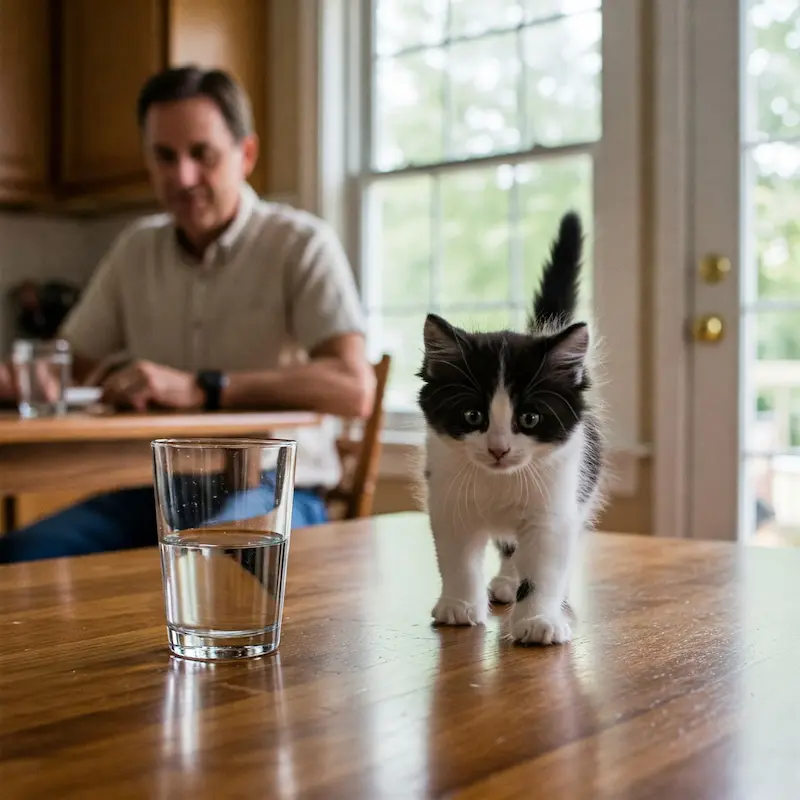
Water plays an essential role in your cat’s overall health, even though they’re often skilled at hiding its importance. Cats are notorious for not drinking enough water, which stems from their evolution as desert-dwelling hunters. However, modern domestication and dietary changes mean that ensuring your feline stays hydrated is more important than ever. Let’s break down why water is essential and what can happen if your cat doesn’t get enough of it.
The Role of Hydration in a Cat’s Health
Water isn’t just a drink for your cat—it’s a lifeline supporting every major function in their body. Proper hydration ensures your cat’s kidneys operate efficiently, filtering waste and balancing necessary minerals. It also aids digestion by softening food and moving nutrients smoothly through the intestines. Without adequate water, these processes can falter, potentially leading to serious health problems.
Additionally, hydration helps flush toxins from your cat’s system through urine. This is especially significant for cats, as dehydration can lead to concentrated urine—a common precursor to urinary tract infections (UTIs) and urinary crystals. While these issues can start small, they may escalate into blockages or kidney disease if left untreated.
Hydration also plays a key role in preventing kidney disease, a common ailment in aging cats. By helping the kidneys function optimally, water reduces the risk of waste build-up in the bloodstream, which is a hallmark of kidney failure.
Preventative care starts with paying close attention to your cat’s water intake. Whether your feline eats a dry food diet or gets moisture from wet food, understanding their hydration needs can steer them clear of these potential issues. A cat water intake calculator can be a helpful tool to measure daily water consumption and adjust to their specific needs.
Risks of Dehydration in Cats
Although cats are quiet about their discomfort, dehydration has a profound effect on them. Learning to spot the warning signs can make a big difference in keeping them healthy. Mild symptoms might include lethargy, where your normally playful cat seems sluggish or spends more time lying around. You might also notice dry, tacky gums if you lift their lip to check inside their mouth.
More severe signs include sunken eyes, a loss of skin elasticity, or panting—none of which should be ignored. One simple way to test your cat’s hydration is through a "skin tent test." Gently pinch the skin at the back of their neck, and if it doesn’t spring back quickly, your cat may be dehydrated.
The consequences of prolonged dehydration are serious. Without enough water, your cat’s organs, especially the kidneys, face extra strain. Chronic dehydration can contribute to kidney diseases or urinary blockages that may become life-threatening if left untreated.
Cats who eat mostly dry food are at an even higher risk since kibble contains far less moisture than wet or raw diets. This is why understanding your cat’s water needs is so important. Using tools like a how much water should a cat drink calculator or a feline water consumption calculator can help provide personalized insight into their hydration habits.
By being proactive, you can help your cat avoid unnecessary discomfort and serious health risks. Ensure fresh, clean water is always available, and monitor how much they’re drinking. Encouraging healthy hydration is one of the simplest yet most effective ways to protect your cat’s health.
How Much Water Does Your Cat Really Need?
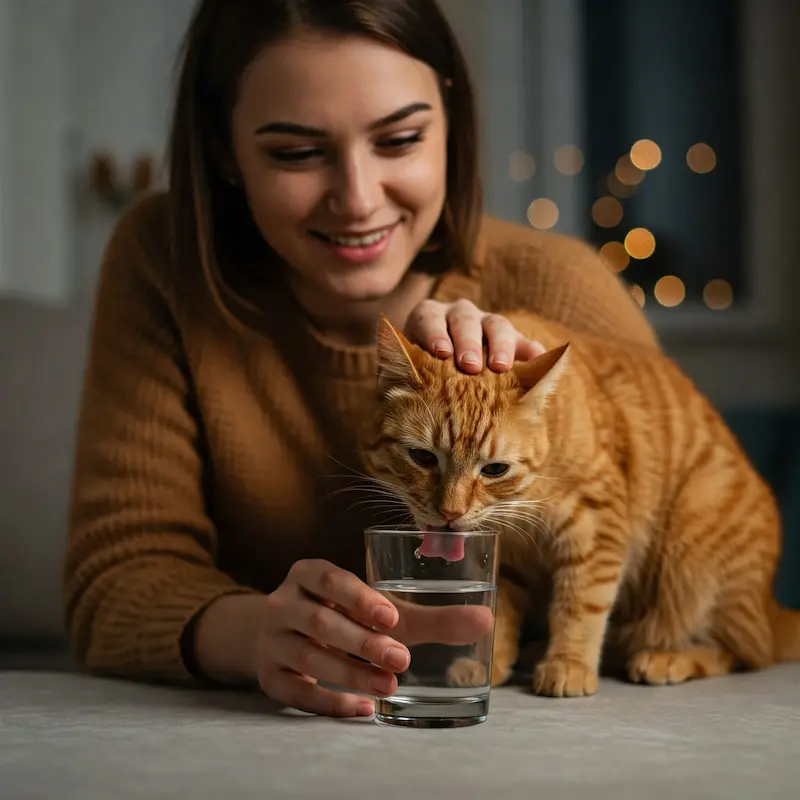
It’s easy to overlook just how much water your cat needs daily. While cats are notoriously self-reliant and rarely show signs of dehydration until it’s a problem, understanding their specific water requirements is crucial. Factors like weight, diet, environment, and lifestyle all influence how much water your cat needs to stay healthy. Below, we’ll break these factors down so you can better ensure your feline is hydrated and thriving.
Daily Water Intake Based on Weight
The simplest way to estimate how much water a cat needs is to calculate it based on their weight. On average, a cat requires 50-70 milliliters (mL) of water per kilogram of body weight each day. This includes both the water they drink and the moisture they derive from their food.
Here’s a quick example:
- A 10-pound cat (approximately 4.5 kilograms) would need 225-315 mL of water daily. To help visualize this, 225 mL is just under a cup, while 315 mL is slightly over 1.3 cups.
Remember, this calculation provides a general guideline. Your cat’s actual water needs may vary based on factors such as their activity level, diet, or even underlying health conditions. Monitoring their drinking habits and overall hydration is the best way to ensure they’re meeting their daily needs.
Impact of Diet on Hydration
What your cat eats plays a massive role in how much water they need to drink. Cats eating primarily dry food (kibble) typically require more supplemental water than cats on wet or raw diets. Dry food contains only about 10% moisture, while wet and raw diets come with high moisture content, usually ranging from 70-80%.
Here’s how this impacts hydration:
- Dry Food Diet:Cats on a strictly dry food diet must drink considerably more water to make up for the lack of moisture in their meals. If your cat shows little interest in their water bowl, they may be at higher risk for dehydration, especially if kibble is their primary food source.
- Wet Food Diet:Wet food provides significant hydration on its own since it’s mostly water. A cat on wet food may drink less from their water bowl, which is generally normal.
- Raw Diet:Similar to wet food, raw diets are high in moisture. Cats on this type of diet may meet much of their hydration needs through their meals. However, active monitoring is still essential since some raw-fed cats may not drink as much water naturally.
For kibble-fed cats, you can encourage hydration by ensuring fresh water is always available, adding water or low-sodium broth to meals, or even introducing a pet water fountain. Wet or raw food diets already support hydration better, but you’ll still want to confirm your cat’s overall water intake is consistent.
Environmental and Lifestyle Factors
The amount of water your cat needs isn’t static—it changes depending on their environment and daily life. Many factors can influence their hydration needs, such as:
- Temperature: In hot weather or warmer indoor conditions, cats lose more water through natural processes like panting or grooming. This increases their need for water, much like it does for people in the summer months.
- Activity Level: Active cats burn more energy, which means they also require more water. Cats who love to run, jump, and play will likely need to drink more than their calmer, nap-loving counterparts.
- Age: Senior cats often need extra hydration due to age-related changes in kidney function. Conversely, kittens might require less water because of their smaller size, although their active play may make their needs seem similar to adult cats at times.
- Health Conditions: Cats with underlying health issues like kidney disease, diabetes, or urinary tract problems may have unique hydration needs. Always consult with your vet if your cat has a medical condition that affects their water consumption.
If the climate is warm, your cat is highly active, or they’re older, being proactive is essential. Provide multiple water sources around your home, consider a cat fountain to entice drinking, and always keep tabs on how much they’re consuming.
By combining this understanding of their weight, food, and environment, you’re much better equipped to calculate and meet your cat’s hydration needs.
Signs Your Cat May Not Be Drinking Enough Water
Cats are notoriously good at hiding when something’s wrong, which makes spotting dehydration a challenge. While their origins as desert animals give them the ability to conserve water, even minor dehydration can lead to significant health problems. As a cat owner, knowing what signs to look for can help you catch dehydration before it becomes dangerous. Below, we’ll explore common symptoms of dehydration and methods you can use at home to check if your cat is getting enough water.
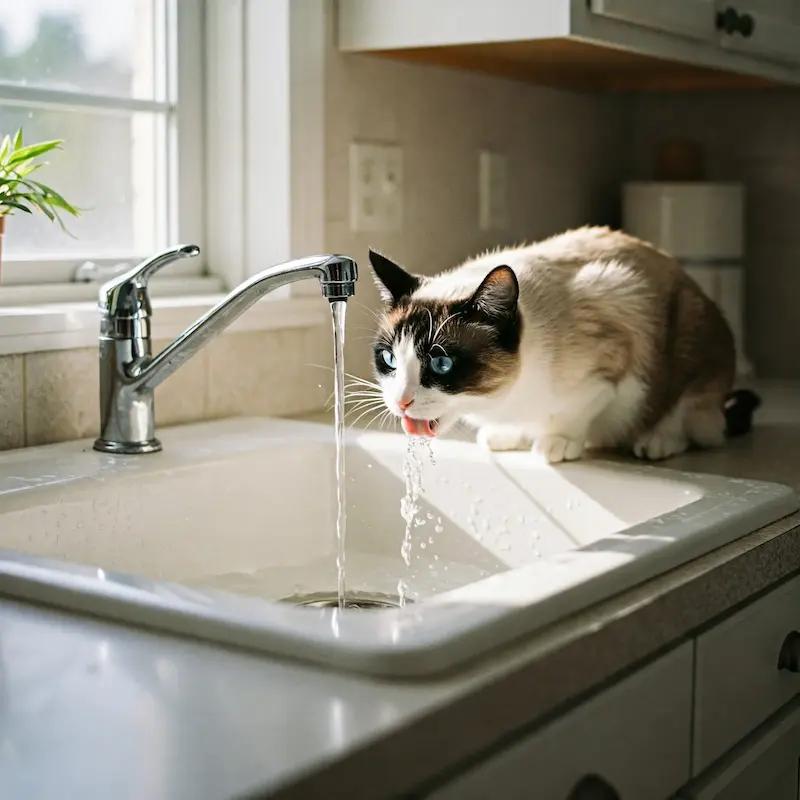
Common Symptoms of Dehydration
Dehydration in cats often reveals itself through subtle changes in their behavior and physical appearance. You might not notice anything at first, but keeping an eye out for the following symptoms can help you determine if there’s a problem:
- Loss of skin elasticity: Cats’ skin should be pliable and return to its natural position quickly when gently pinched. If it stays in a "tent" shape or moves back slowly, dehydration could be the culprit.
- Dry or sticky gums: A hydrated cat’s gums should be moist and slippery. Dry or tacky gums are a common sign of dehydration.
- Lethargy or lack of energy: If your typically active cat seems tired, sluggish, or less engaged, this could point to dehydration affecting their overall energy levels.
- Loss of appetite: Dehydration can make your cat feel unwell, resulting in a decreased interest in food.
- Sunken eyes: A cat’s eyes may appear dull or recessed if they’re dehydrated, an indicator that requires quick attention.
- Excessive panting: While cats don’t pant as often as dogs, this behavior can signal overheating or dehydration, especially in warmer weather.
- Thick saliva: Sticky or thick saliva indicates an imbalance in hydration levels and may point to dehydration.
If you notice one or more of these symptoms, it’s time to take action. Mild dehydration might be reversible at home, but severe cases require immediate veterinary care to avoid complications.
How to Check for Dehydration at Home
When you suspect your cat isn’t drinking enough water, a few simple at-home tests can confirm your concerns. These tests are safe, quick, and can give you an idea of whether your cat needs extra help staying hydrated.
-
Skin Elasticity Test (or “Skin Tent Test”)
The skin elasticity test is one of the easiest signs of dehydration to identify. Here’s how to do it:
- Gently pinch a small section of skin at the back of your cat’s neck or between their shoulder blades.
- Release it and observe how quickly the skin returns to its normal position.
- If the skin snaps back immediately, your cat is likely well-hydrated. If it takes longer to settle, dehydration could be an issue.
-
Check Gum Moisture
Another quick way to assess hydration is to check your cat’s gums. Follow these steps:
- Gently lift your cat’s upper lip to expose their gums (this should be done calmly to avoid stress).
- Lightly press your finger against the gum, then release it.
- In a well-hydrated cat, the gums will appear pink, moist, and smooth. Upon pressing, the color should quickly return to pink after turning white for a moment.
- Monitor Water Consumption Keeping an eye on how much water your cat is actually drinking is another practical way to gauge hydration. Using a simple water measuring method at home or tracking their intake with a tool like a cat water intake calculator can provide insight into their daily habits. If their consumption suddenly decreases, it’s worth investigating further.
If these tests suggest dehydration, start by encouraging your cat to drink more water. Offer fresh water frequently, place multiple bowls around your home, or use a cat fountain to make drinking more appealing. For more serious symptoms, contact your vet as soon as possible to prevent further complications.
Using the calculator just once isn’t enough. Cats’ needs change with age, diet shifts, and even the seasons. Revisit it periodically to ensure you’re providing up-to-date care for your furry friend.
Tracking Your Cat’s Water Consumption
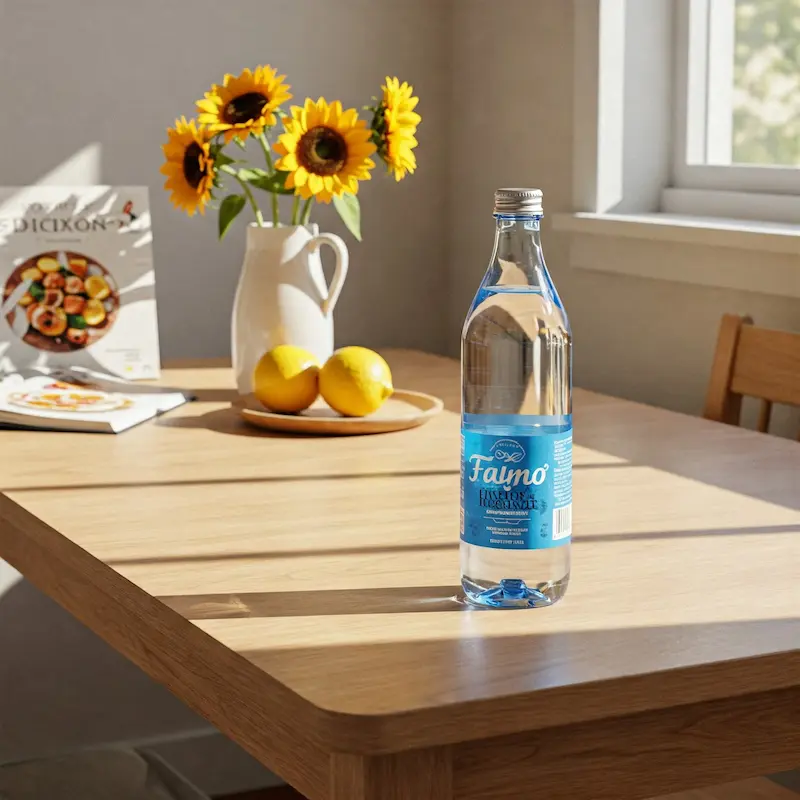
Once you’ve calculated your cat’s daily water requirement, the next step is to monitor their actual consumption. Knowing how much they’re drinking helps you spot inconsistencies or potential issues. Here are some practical tips and tools to help you keep track:
-
Use Measured Water Bowls
Start by putting a specific amount of water in your cat’s bowl at the beginning of the day. At the end of the day, measure what’s left. Subtract the remaining amount from the original volume to determine how much your cat drank.
-
Offer Multiple Water Sources
Cats can be picky about where and how they drink. Placing multiple bowls around your home—especially in areas they frequent—can encourage more water consumption. Track usage from all the sources combined.
-
Try a Cat Water Fountain
Many cats are drawn to moving water. Investing in a cat water fountain can not only encourage hydration but also make tracking easier by focusing their drinking habits in one spot.
-
Incorporate Tracking Tech Tools
For a high-tech solution, there are smart water bowls and hydration tracking devices designed specifically for pets. These tools monitor how much your cat drinks in real time and often sync with apps on your phone for easy tracking and reminders.
-
Monitor Food Intake for Hidden Hydration
Remember, a significant portion of your cat’s water intake comes from their food, especially if they eat wet or raw diets. Pay close attention to their meals when calculating their total daily hydration. For instance:
- Wet food contains about 70-80% water.
- Dry kibble has only 10% or less moisture.
Combine this information with their water bowl consumption to see if they’re meeting their target.
-
Look for Patterns and Adjust as Needed
Over time, patterns will emerge. Perhaps your cat drinks less on days they eat extra wet food or more when the temperature rises. Tracking lets you adjust accordingly and ensures they’re consistently hydrated.
Keeping tabs on water intake doesn’t need to feel like a chore. Simple habits like refilling their bowl at the same time each day or using a tracker app can make the process seamless. With this data in hand, you can ensure your cat’s hydration aligns with what the cat water intake calculator recommends, keeping them happy, healthy, and hydrated.
Tips to Encourage Your Cat to Drink More Water
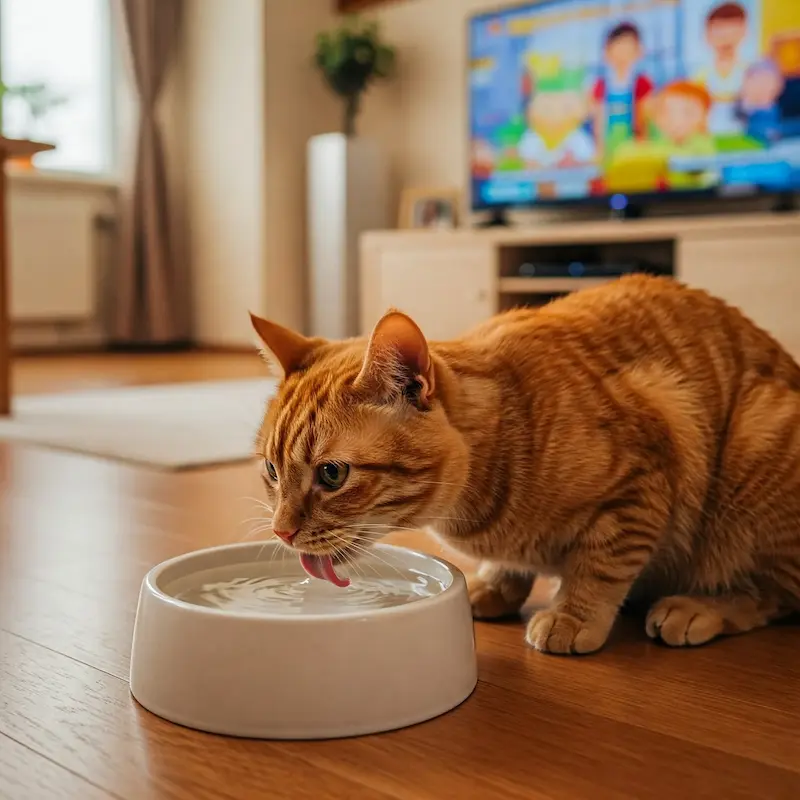
Getting your cat to drink enough water can feel like an uphill battle, especially if they’re one of those felines who barely glance at their water bowl. But proper hydration isn’t just a minor part of your cat’s health—it’s essential.
Provide Fresh and Clean Water
Cats can be surprisingly selective about their water, so keeping it fresh and clean is non-negotiable. Refresh their water at least once or twice a day to ensure it’s always enticing.
Opt for non-porous materials like stainless steel, glass, or ceramic. Also, be sure to clean the bowl daily with soap and water. If your tap water is hard or heavily chlorinated, try filtered or bottled water.
Use Interactive and Appealing Drinking Options
A cat water fountain can pique their interest with movement and sound. Try flavored water additives like low-sodium chicken broth (vet-approved) or flavored ice cubes to spark curiosity and boost intake.
Incorporate Wet Foods into Their Diet
Wet cat food contains about 70–80% moisture, unlike dry food which has 10% or less. Mixing in wet food, or adding water or broth to kibble, helps increase hydration through meals.
Hydration-enhancing toppers like broths, powders, or treats can be useful for picky eaters too.
Place Water Stations Throughout the House
Adding multiple water bowls in your cat’s favorite spots makes drinking more convenient. Avoid placing them near the litter box, and experiment with bowl placement to find what your cat prefers.
In multi-pet homes, place bowls in quiet areas to reduce resource guarding and help shy cats drink more confidently.
By taking these actionable steps, you can make drinking water a regular and enjoyable part of your cat's daily routine.
Conclusion
Your cat’s hydration is more than just a daily concern—it plays a vital role in their long-term health and happiness.
Using a cat water intake calculator makes it simple to understand and meet their hydration needs. Monitor their intake, watch for signs of dehydration, and try small changes like adding wet food or using a fountain.
Take the next step: use the calculator, track their habits, and implement these tips. A well-hydrated cat is a happy, energetic companion—and caring for them in this way is one of the best gifts you can give.
How Much Water Should Your Cat Drink? FAQs
- How much water does a cat need daily?
- On average, cats need about 3.5–4.5 ounces of water per 5 pounds of body weight daily. This includes moisture from wet food and any water they drink.
- Do cats get enough water from wet food?
- Cats eating wet food get a lot of moisture from it, as it’s about 70-80% water. However, they may still need to drink additional water, depending on their activity level and overall health.
- What if my cat only eats dry food?
- Cats on a dry food diet need to drink more water since dry food contains only about 10% moisture. Make sure fresh water is always available to help them stay hydrated.
- How can I tell if my cat is dehydrated?
- Signs of dehydration include dry gums, loss of skin elasticity, lethargy, or sunken eyes. If you suspect your cat is dehydrated, contact your vet for guidance.
- Can a cat drink too much water?
- Excessive drinking may signal health issues like diabetes or kidney problems. If your cat is drinking significantly more than usual, consult your vet.
- How can I encourage my cat to drink more water?
- Try using a water fountain, placing multiple water bowls around your home, or adding water to their food. Cats are often attracted to moving water, so a fountain may help.
- Should I use a water intake calculator for my cat?
- A water intake calculator can give helpful estimates, but remember, individual needs vary. Factors like age, weight, diet, and activity level all affect how much water your cat requires.
- Are there specific water bowl preferences for cats?
- Cats often prefer shallow, wide bowls to avoid whisker stress. Stainless steel or ceramic bowls are also good options, as they’re easier to clean and don’t retain odors.
- Is it safe for my cat to drink tap water?
- Most tap water is safe, but if your water has high levels of chlorine or other additives, filtered or bottled water may be a better choice.
- How do I calculate my cat’s exact water needs?
- To estimate: Multiply your cat’s weight in pounds by 0.7–1.0 ounces. This gives a daily range, but factors like diet and health should also be considered.
- When should I worry about my cat’s water intake?
- If your cat suddenly stops drinking or drinks excessively, it could indicate a problem. Changes in appetite or bathroom habits are also warning signs. Speak to your vet if you notice any of these changes.
CatsLib.com relies on trusted, high-quality sources, including peer-reviewed research, to back the information in its articles. We regularly review and update our content to ensure it remains accurate and reliable.
- Case, L. P. (2010). The Cat: Its Behavior, Nutrition & Health.
- Fascetti, A. J., & Delaney, S. J. (2012). Applied Veterinary Clinical Nutrition.
- Debra Eldredge. Cat Owner's Home Veterinary Handbook
- Gary Landsberg et al. Behavior Problems of the Dog and Cat
- Cat Health
- Water Consumption in Cats – VCA Animal Hospitals
- How Much Water Should a Cat Drink – PetMD
Recent Articles

Why Are Siamese Cats Cross Eyed? Genetics, Health, and Care Guide

Do Ragdoll Cats Shed a Lot? Seasonal Tips to Manage Fur and Keep Your Home Clean

10 Medical Reasons Your Cat Is Walking in Circles – Signs You Should Never Ignore

Why Does Your Cat Scratch Around Its Food Bowl? Top Reasons and Simple Solutions
